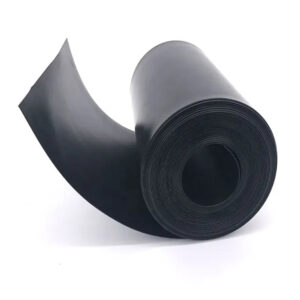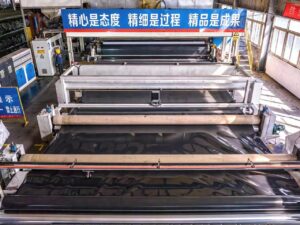What is geomembrane used for?
Geomembrane is a geotechnical material used for waterproofing, anti-seepage and isolation. Its main function is to prevent moisture, chemicals or other harmful substances from penetrating into the soil or other structures in engineering projects. The following are the main uses of geomembrane:
Anti-seepage layer: Geomembranes are widely used in water conservancy projects, landfills, chemical plants and other places where waterproofing or anti-seepage is required. In water conservancy projects such as dams, reservoirs, and canals, geomembranes are used as anti-seepage layers to prevent water from penetrating into the soil and maintain the effectiveness of water storage and delivery systems.
Landfill: In the construction of landfills, geomembranes serve as an anti-seepage layer to prevent liquids in waste from penetrating into groundwater or soil, thereby reducing environmental pollution.
Chemical plants: In industrial facilities such as chemical plants and fertilizer plants, geomembranes are used to prevent chemicals from seeping into the ground and protect groundwater resources and the quality of the surrounding soil.
Basic engineering: Geomembrane can be used in basic projects such as roads, bridges, and tunnels as a waterproof layer to prevent groundwater from penetrating into the basic structure, thereby enhancing the stability and durability of the project.
Mining Engineering: In mining engineering, geomembranes are used to prevent slag, ore or toxic chemicals from penetrating into the soil and reduce adverse effects on the surrounding environment.
Soil and Water Conservation: In some soil and water conservation projects, geomembranes can be used to prevent water flow and soil erosion, protect surface coverage, and promote the growth of vegetation.

What is the difference between geomembrane and geotextile?
Geomembranes and geotextiles are two different types of geomaterials, and they have some significant differences in structure, use and performance. The following are the main differences between geomembranes and geotextiles:
Materials and construction:
Geomembrane: Usually made of plastic materials such as polyethylene (HDPE, LLDPE), polyvinyl chloride (PVC), polypropylene (PP). Geomembrane is a continuous membrane with high waterproof and anti-seepage properties. It is usually produced by extrusion or calendering and has a smooth surface and a uniform structure overall.
Geotextile: Mainly made of synthetic fibers such as polypropylene or polyester, formed through processes such as needle punching, hot melting or chemical bonding. Geotextile is a discontinuous, mesh-structured material with good tensile strength and water permeability. Its structure is similar to textiles and is porous and water-permeable.
use:
Geomembrane: Mainly used in waterproofing, anti-seepage and isolation projects, such as landfills, reservoir anti-seepage layers, road foundations, etc. Geomembrane can effectively isolate water and soil, prevent water penetration, and has strong anti-seepage properties.
Geotextiles: Mainly used in projects such as enhancing the tensile strength of soil, inhibiting erosion, and protecting vegetation. It is commonly used in slope protection, road foundation reinforcement, soil and water conservation, vegetation coverage and other applications to improve engineering performance by increasing soil stability and erosion resistance.
Performance features:
Geomembrane: It has good anti-seepage performance and can effectively isolate water and soil. It is usually thin and flexible and can adapt to more complex terrain.
Geotextile: It has good tensile strength and water permeability, and can enhance the stability of the soil. The permeability of geotextile allows water to penetrate freely, avoid water erosion, and promote the growth of plants in the soil.
Generally speaking, geomembranes and geotextiles have their own unique application areas in engineering, and the choice depends on specific engineering needs and environmental conditions. Sometimes the two can also be used together to bring out the advantages of each. When selecting and using these materials, careful consideration should be given to the specific requirements of the project and decisions should be made based on the advice of the engineering designer or professional engineer.
What are the physical properties of ?
Geomembranes are geomaterials used for waterproofing, impermeability, and isolation, and their physical properties cover a range of properties related to their structure and performance. Here are some common physical properties a geomembrane may have:
Thickness: The thickness of a geomembrane is usually measured in millimeters (mm). Different engineering applications may require different thicknesses of geomembranes, with thicker membranes typically used to withstand more severe environmental conditions.
Density: The density of a geomembrane refers to its mass per unit volume, usually in grams per cubic centimeter (g/cm³). Density is related to the thickness and material of the geomembrane, and generally speaking, a higher density may mean a stronger membrane.
Tensile strength: The tensile strength of geomembrane refers to the membrane’s resistance to tensile force. This feature is crucial to ensure that the geomembrane will not break or deform easily during use.
Tear strength: Tear strength is the resistance of the geomembrane when subjected to tearing force. This is related to the damage resistance and tear resistance of the geomembrane.
Puncture Strength: Puncture strength is the resistance of a geomembrane to puncture or puncture. This characteristic is related to the damage that the geomembrane may suffer in actual use.
Water permeability: Geomembranes usually have some water permeability to allow groundwater or rainwater to flow underneath the membrane. This is a necessary feature in some applications, such as preventing groundwater levels from rising downstream of a dam.
Temperature stability: Geomembranes need to have a certain temperature stability to maintain their performance under different climate conditions. This includes low and high temperature resistance.
Flexibility: The geomembrane needs to have a certain degree of flexibility to adapt to possible terrain changes and deformations during the project.
UV stability: Geomembranes need to have certain UV resistance when used outdoors to prevent long-term sunlight from affecting their structure and performance.



